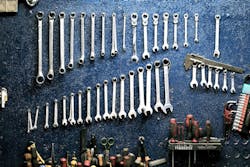Many shop owners struggle with an OE dilemma: to order, or not to order? Some believe that it’s the OE way or the highway as far as sourcing replacement parts, and drivers want to know their vehicle components are safe, reliable, and have undergone the same scrutiny as when the vehicle was brand-new, fresh off the factory line.
According to a recent report by V12 (an automotive industry data and marketing company), the global automotive aftermarket industry is expected to grow; by 2020, it will be a $722.8 billion industry. The average American car on the road is 11.5 years old—they are made to last longer, perform better, and require less upkeep than ever before, meaning drivers are keeping them in their garages (and using the same service shops) to keep their engines running, spurring a demand for the automotive aftermarket like never before.
And those cars need repairs. But is OE the only option? Many shops want to save their customers money by offering equal (and often superior) parts and components at a lower cost than their OE counterparts, and overcoming industry myths is a tricky business.
Let’s take a look at a few.
Myth #1: Aftermarket Parts Are Not Professional-Grade: FALSE
When a shop in Wisconsin needs an intricate, specific interior component for a foreign manufacturer’s vehicle, for example, being able to reach for a product tailor-made for that specific repair doesn’t always mean reaching for an OE part.
Manufacturers and shops sometimes refer to these aftermarket options as “problem-solver” parts; parts engineered and designed to fix specific issues that only came to light years after the OE part was manufactured—and failed. Aftermarket options, such as ACDelco, Interstate, and Motorcraft, etc., often feature lighter, stronger materials, are easier to install, and often last longer. They are tailor-made to fix specific issues, making sure that under-hood rattle you always heard over 65 miles per hour is never heard again.
From an OE’s perspective, this makes sense—why spend the time (which is money) and resources (their employees) to produce a better replacement part when they know shops and vendors will often order the original—and occasionally inferior—OE-stamped component?
Some industry-leading aftermarket brand components undergo as rigorous of testing as their OE counterparts. For example, Duralast parts endure extreme third-party testing to ensure first-world quality. Independent, third-party quality-control checks ensure product requirements are met. They check the internal and external engineering. They double-check parts selection, performance testing, and overall construction. Duralast-brand products undergo rigorous like-for-like testing on randomly selected parts against OEM counterparts, ensuring like-for-like value and performance. Unbiased random selections from different factories and components keep everyone on their toes.
Aftermarket OE quality–plus parts are often available through your local parts store (Duralast sells exclusively to AutoZone). You don’t need to head to the dealership to get what you need—you just need to ask the right questions.
Myth #2: Aftermarket Parts Manufacturers and Factories Are Questionable: FALSE
“Quality-assured” factories and manufacturers earn that title by conducting regular, stringent, comprehensive tests on the factory line, as well as upon the manufactured components themselves. If any part of that process fails, the entire endeavor fails, much like a broken cog in the middle of a massive machine. No matter where a component comes from, however—rubber from Latin America, computer chips from Ireland, shocks and struts from China—“quality assured” means the same thing.
Aftermarket factories are pre-qualified by third-party assessors to determine only the highest quality factory standards are met, followed, and maintained over time. A case in point, Duralast partners directly with manufacturers to monitor every aspect of quality control and production. By doing that, parts companies vet all parts before they leave the line, which ensures low-cost, highly effective automotive parts. The vetting includes pre- and post-shipment inspections and random and annual testing.
And that’s just to get a foot in the door. That’s the first step before a shop ever unboxes that package of struts for which they’ve been waiting.
Myth #3: Aftermarket Parts Are Simply DIY Brands: FALSE
OEs work to design, manufacture, and deliver vehicle innovations—and sell cars. The automotive aftermarket is dedicated to keeping those cars running, just like the independent repair shop.
With the same goals, same vision, and same approach, many of the industry’s top repair operations turn to aftermarket parts, not just because of the more affordable prices for customer (and beneficial price margins for their operations) but also because they realize the dedication to an improved product that sustains the longevity of a vehicle.
Vehicle owners put their trust in their local technicians to fix the vehicle right, the first time. Dependability is what wins long-term customers and long-term viability for their operations, and the stringent testing, as well as superior innovation, in aftermarket parts allows shop owners to trust that they are doing what’s right for their customers as well as their businesses.
Aftermarket parts aren’t just an alternative to OE products. For professional installers around the country, they are the best option for repairing a vehicle to OE standards of safety, quality, and dependability.



